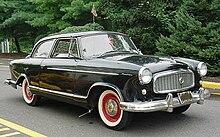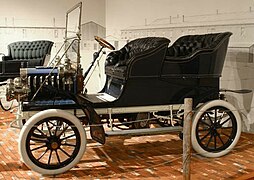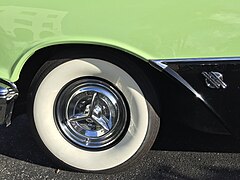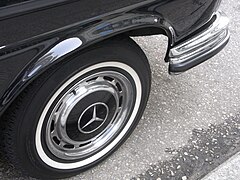Whitewall tire
 From Wikipedia the free encyclopedia
From Wikipedia the free encyclopedia

Whitewall tires or white sidewall (WSW) tires are tires having a stripe or entire sidewall of white rubber. These tires were most commonly used from the early 1900s to around the mid 1980s.
Background
[edit]The use of whitewall rubber for tire has been traced to a small tire company in Chicago called Vogue Tyre and Rubber Co that made them for their horse and chauffeur drawn carriages in 1914.[1]
Early automobile tires were made of pure natural rubber with various chemicals mixed into the tread compounds to make them wear better.[2] The best of these was zinc oxide, a pure white substance that increased traction and also made the entire tire white.[2] However, the white rubber did not offer sufficient endurance, so carbon black was added to the rubber to greatly increase tread life.[3] Later, entirely black tires became available, the still extant white sidewalls being covered with a somewhat thin, black colored layer of rubber. Should a black sidewall tire have been severely scuffed against a curb, the underlying white rubber would be revealed; it is in a similar manner that raised white letter (RWL) tires are made.[citation needed]
Overview
[edit]The status of whitewall tires versus blackwall tires was originally the reverse of what it later became, with fully black tires requiring a greater amount of carbon black and less effort to maintain a clean appearance these were considered the premium tire; since the black tires first became available they were commonly fitted to many luxury cars through the 1930s. During the late-1920s gleaming whitewalls contrasted against darker surroundings were considered a stylish, but high-maintenance feature. The popularity of whitewalls as an option increased during the 1930s. On 6 April 1934, Ford introduced whitewall tires as an $11.25 (equivalent to $256 in 2023) option on all its new cars.[4] But automobile designs incorporating streamlining directed visual interest away from tire walls.

The availability of whitewall tires was limited in the US during the supply shortages of raw materials during World War II and the Korean War.[5]
Wide whitewall tires reached their height in popularity by the early-1950s. The 1957 production version of the Cadillac Eldorado Brougham was fitted with whitewalls that were reduced to a 1" wide stripe floating on the tire sidewall with a black area between this stripe and the wheel rim. The whitewall stripe width began to diminish as an attempt to reduce the perceived height of the wheel/tire. During the decade, increasingly lower vehicle heights were in vogue. During the 1950s, Fender skirts also covered up white wall tires.[6]
Wide whitewalls generally fell out of favor in the US by the 1962 model year. They continued as an option on the Lincoln Continental for some time thereafter but most common were narrower 3⁄4–1-inch (1.9–2.5 cm) stripe whitewalls. During the mid-1960s variations on the striped whitewall began to appear; a red/white stripe combination was offered on Thunderbirds and other high-end Fords, and triple white stripe variations were offered on Cadillacs, Lincolns, and Imperials. Whitewall tires were a popular option on new cars during the 1950s and 1960s, as well as in the replacement market. In some cases, having whitewall tires were a "must have" to get the right look on a car; and for those who could not afford the real deal, add-ons could be installed over the rim of the wheel that could leak if the pressure was too high.[7]
New tires were wrapped in paper for shipping, to keep the white stripe clean, and for preventing the black of other tires from rubbing on the whitewall side.[8] Maintaining a clean sidewall was an issue. Some motorists added aftermarket "curb feelers" that were attached at the bottom of the wheel opening lip to help reduce scraping the whitewall tire against curbs.[9]
By 1968, wide whitewall tires were no longer available on the Chevrolet Corvette; replaced by F70x15 bias-ply nylon cord tires with thin stripes, either a narrow white or narrow red stripe.[10]
The single-sided whitewall remained a desirable option through the 1970s, becoming a hallmark of "traditional luxury". Radial tires made by Vogue Tyre featured a narrow whitewall with a thin gold stripe line toward the edge of the tire. They were most often fitted to luxury cars.[11]
Modern
[edit]Full-fledged wide whitewalls have made a return within modified car culture. The resurgence of traditional hot rods, customs, retro, lowriders and resto-cal cars have also contributed to the resurgence in whitewall tires.
Although wide whitewalls are virtually nonexistent as a factory option on modern automobiles, they are still manufactured in original bias-ply or radial form by specialty outlets such as Diamondback Classic tires, Coker Tire and Vogue Tyre. The last car available in the United Kingdom with whitewall tires was the Kia Pride. Some companies manufacture wide whitewall inserts - the so-called "Portawall" inserts are usually sold through Volkswagen Beetle restoration companies. Another modern incarnation has been tire decals, which can be applied to a normal tire to give the whitewall look.
Modern trends toward more minimal styling, and large wheels favoring very low-profile tires leave little room for a whitewall. The Lincoln Town Car continued to be offered with a factory whitewall option—a narrow white stripe—until its discontinuation in 2010. It is not currently offered as a factory option by any car manufacturer, but it is possible to order whitewalls for motorcycles (for example, the 2014–present Indian Chief).
Gallery
[edit]- 1904 Auburn with all white rubber tires
- 1913 American Underslung with all white tires
- 1913 Indian Big Twin with standard white rubber tires
- Firestone Deluxe Champion Whitewall sparetire (with thick white band) on a 1932 Nash Coupe
- Wide whitewall tires were popular on premium automobiles
- 1956 Oldsmobile Super 88 with Coker Classic whitewall tires
- The white stripes on tires became narrower as the 1960s progressed
- Narrow gold stripe performance tire from the 1960s
- Redline tires were commonly fitted on performance cars in the late 1960s
- Buick Electra with white stripe tire partially covered by a fender skirt
- Narrow stripe white wall tires were common throughout the 1970s and into the early 1980s, some luxury carmakers still offered them late into the 1990s
- A variation with white letters on the sidewall found on muscle car tires, these are still used on modern SUVs
References
[edit]- ^ Ryan (7 June 2006). "The History Of The Whitewall: Part 2!". Jalopy Journal. Retrieved 10 September 2013.
- ^ a b Cameron, Kevin (2009). Top dead center 2 : racing and wrenching with Cycle world's Kevin Cameron. MBI Publishing. p. 167. ISBN 9780760336083. Retrieved 10 September 2013.
- ^ Cameron, p. 169.
- ^ Sullivan, Kate (6 April 2013). "This Day in History: Ford offers whitewall option". Hemmings. Retrieved 10 September 2013.
- ^ Flory, J. Kelly (2008). American cars, 1946-1959: every model, year by year. McFarland. p. 12. ISBN 978-0-7864-3229-5. Retrieved 10 September 2013.
- ^ Kaufman, Burton Ira; Kaufman, Diane (2009). The A to Z of the Eisenhower era. Scarecrow Press. p. 24. ISBN 9780810871502. Retrieved 10 September 2013.
- ^ Glabach, Ray (2011). The Last Village Smithy: Memories of a Small Town in the New England Hills. AuthorHouse. p. 294. ISBN 978-1-4567-5901-8. Retrieved 10 September 2013.
- ^ Walesh, Stuart G. (April 2010). "Still Wrapping Tires in Brown Paper?". Leadership and Management in Engineering. 10 (2): 96. doi:10.1061/(ASCE)LM.1943-5630.0000054. Retrieved 10 September 2013.
- ^ Automotive News. Crain Automotive Group. 1981. p. 100. Retrieved 10 September 2013.
- ^ Falconer, Tom (2003). Complete Corvette: A Model-by-Model History of the American Sports Car. MBI Publishing. p. 61. ISBN 978-0-7603-1474-6. Retrieved 10 September 2013.
- ^ Perea, Sammy J. (February 2009). "History of the Wheel: A loose look at the wheels and tires that lowriders have loved to roll on". Lowrider. Archived from the original on 26 August 2012. Retrieved 10 September 2013.











